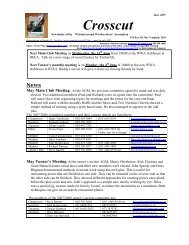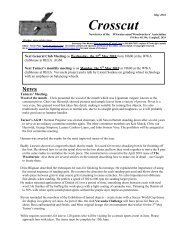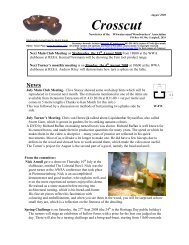Crosscut - Wits Woodworking Association
Crosscut - Wits Woodworking Association
Crosscut - Wits Woodworking Association
Create successful ePaper yourself
Turn your PDF publications into a flip-book with our unique Google optimized e-Paper software.
July 2010<br />
<strong>Crosscut</strong><br />
Newsletter of the Witwatersrand Woodworkers’ <strong>Association</strong><br />
PO Box 411346, Craighall, 2024<br />
Rebate plane – Stanley #78 – In production since 1885 and still available new.<br />
Secretary: Ken Mutch (Ken.woodman AT gmail.com or 082 806 7693 - replace AT with @ to email)<br />
Editor: Trevor Pope (tpope AT iafrica.com). All written content and opinions are those of the editor, unless stated. © Copyright reserved.<br />
Go to http://mysite.mweb.co.za/residents/tpope/homepage.html for back issues of <strong>Crosscut</strong>.<br />
Next General Club Meeting on Wednesday, the 14 th July 2010 from 18h00 at the WWA<br />
clubhouse at REEA. Demonstration by Manuel Cardoso-lopes on sharpening woodworking tools,<br />
in particular plane blades.<br />
Next Turner’s monthly meeting is on Monday, the 5 th July 2010 at 18h00 at the WWA<br />
clubhouse at REEA. Peter Middleton will demonstrate the use of the bedan.<br />
News<br />
Turners’ Meeting.<br />
Wood of the Month - Chris van Heeswijk presented Imbuia - Ocotea Porosa. Imbuia is widely used in cabinet making.<br />
It has a distinctive peppery aroma when cut and it works and finishes well. It is listed as a vulnerable species.<br />
Herman collected the vuvuzelas for the exhibition, which included a couple of reworked/refinished ones.<br />
Herman chaired the meeting. He opened the meeting, with a proposal of how the two committees are to be combined<br />
to form a single committee. This was ratified by the meeting.<br />
Peter Middleton showed his design for a bedan and the special tool handles he<br />
makes to hold them. He showed an example of spindle work done entirely with<br />
his bedan. The bedan and handle are available from Peter for R350-. For those<br />
who don’t know what a bedan is, the diagram on the right shows the geometry of<br />
the tip of the tool. Robert Sorby also make one.<br />
Steven Barrett demonstrated making an apple using a chuck on the Nova lathe.<br />
Main Club Meeting<br />
Alastair, who is the deputy chairman, opened the meeting, with a proposal of how the two committees are to be<br />
combined to form a single committee. This was ratified by the meeting, so the new arrangement for the management<br />
of the WWA is now in effect. Alastair reported that at the AGM, Harold Theunissen and Costa Carastavrakis were<br />
accepted as life members of the club, for their service to the club.<br />
Ken Mutch explained the arrangements for distribution of newsletters for those who are unable to receive them by<br />
email. Copies will be made for distribution at the next meeting for those that<br />
request them. Postal copies are still available for those that request them at a cost<br />
of R80- per year, to cover the cost of printing, envelopes and postage. This is still<br />
partly subsidized by the WWA. Please contact Ken, who distributes the<br />
newsletters.<br />
List of committee contact details – Ask Ken for these<br />
Alistair demonstrated the Lennox bi-metal jig-saw blade for wood and its ability to<br />
cut through metal as well as make clean cuts through wood.<br />
Mervyn Davies is a luthier who specializes in acoustic guitars. He showed some<br />
examples of his work. He explained some of his construction techniques and<br />
showed an example of a classical guitar. He also showed a novel new concept, that
<strong>Crosscut</strong> -July 2010 - Page 2<br />
he calls the SmoothTalker which is a modular design. There are some pictures on his web site of examples of his<br />
work.<br />
AWSA 2010 Symposium<br />
If you are a member of the <strong>Association</strong> of Wood-turners of South Africa, you will have received the latest newsletter<br />
with the details of the 2010 Symposium. It will be held in PE at the Cape Recife School from Friday, 24 th to Sunday,<br />
26 th September. The overseas turner is Trent Bosch (see www.trentbosch.com). If you haven’t attended an AWSA<br />
symposium before, it is highly recommended – 2½ days immersed in turning, with exposure to a leading overseas<br />
turner will take your turning to a new level. More details in the next <strong>Crosscut</strong>.<br />
ANNUAL MEMBERSHIP SUBSCRIPTIONS: 2010 / 2011 year - Reminder<br />
Payment of subs. We have experienced difficulty with the tracking down of all subs paid. Please can members ensure that they<br />
make cash payments directly to the treasurer (Steven Barrett) and that they receive a receipt for future reference. Please send all<br />
changes of address direct to the secretary.<br />
Please Note:<br />
Toymakers. The toymakers meet on the first and third Mondays of every month, at 09h00 till 12h00 at the clubhouse. Contact<br />
Eddie Marchio on 011-678-8062 or renato AT pixie.co.za for more information.<br />
Wednesday Workshop. The Wednesday evening workshops are on the first and third Wednesdays of every month, from 18h00<br />
till 20h00. Contact Winston Klein on 011-674-1513 for more information.<br />
Groz Block plane – worth the money?<br />
INVOICE<br />
DUE DATE AMOUNT<br />
1/5/2010 SUBS for the Witwatersrand Woodworkers <strong>Association</strong> -<br />
2010/2011 year<br />
Direct deposits to: Witwatersrand Woodworkers <strong>Association</strong>.<br />
Nedbank Main St. branch - Code: 198765. Account No:<br />
1979-321833 – Put your name in the comment line, so that<br />
the treasurer can identify the source of the payment.<br />
R290-00<br />
A block plane is small plane that can be used with<br />
one hand. They are often used for trimming, and<br />
some carpenters carry one around in the pocket<br />
of their apron, hence they are sometimes called<br />
apron planes. One well-known example is the<br />
Stanley 60½. This is a low angle block plane that<br />
is a handy tool for trimming edges. The low<br />
12.5° angle of the blade works well for trimming<br />
end-grain. The bed angle for the blade is 12.5°<br />
and it is sharpened at 25°, making an overall<br />
cutting angle of 37.5°. (The standard angle of a<br />
bench plane is 45° which is a good overall<br />
compromise.) The lower angle does give better<br />
performance in end grain.<br />
The main problem with the Stanley 60½ is that it<br />
is, alas, rather expensive for a casual user. So I<br />
was tempted by a budget plane from Groz (model BP-605 at £14-30) to give as a gift. It is a lot cheaper, so I<br />
expected that it would require some work.
It turns out that it is not nearly as well made as<br />
my English-made Stanley 12-060. From the<br />
picture, you can see that they are very similar in<br />
appearance. There are some differences in the<br />
details.<br />
The bodies of the planes are the same size. The<br />
blade angle of the Groz is 13.5° which is<br />
practically the same. The clamping toggle is<br />
made from pressed steel and does not work as<br />
well as the Stanley’s cast item. Both the knobs<br />
on the Groz stick out more and are less<br />
comfortable to use. On the 60½ type planes, the<br />
mouth opening in front of the blade can be<br />
adjusted by slackening the front knob and<br />
moving the lever. However on the Groz, out-ofthe<br />
box, it is not possible to close up the mouth,<br />
even when the lever is fully over. You can see<br />
the difference between the two in the picture.<br />
The Stanley can close right up, whereas the Groz<br />
has a large gap remaining. You can also see<br />
some other issues visible in the photo of the<br />
Groz – the side of the sole plate the forms the<br />
front of the mouth is skew, (which was easily<br />
corrected by filing), and there are chips in the<br />
paint, new out-of-the-box. Also, you can see<br />
signs of incipient rust on the cap iron, above the<br />
name.<br />
To close up the mouth, I filed the slot in the<br />
adjustment lever to extend it, which helps. It is<br />
then far over to the side for a small mouth<br />
opening. The picture shows this with the front<br />
knob removed for clarity. Doing this locates the<br />
sole plate further back to close up the mouth, but<br />
it leaves an unsightly gap in the front, with some<br />
sharp points exposed. The Groz is on the right,<br />
and the Stanley on the left. Groz changed the<br />
design slightly, but clearly, somebody did not<br />
<strong>Crosscut</strong> -July 2010 - Page 3<br />
get their sums right. I removed the sharp edges by<br />
grinding the front of the sole as shown in next the<br />
picture on the left. (I wonder whether the sole plate<br />
was not inserted the wrong way around, before being<br />
ground to fit?)
The main problem is the blade supplied with the<br />
Groz, which is useless. On the box, it says that<br />
the blade is hardened to 58-62 RC, which is<br />
what one would expect from a decent carbon<br />
steel blade. However, this is not the case. It is<br />
so soft, that the edge turns on SA pine after a<br />
couple of cuts. In the picture, you can see how<br />
the edge has turned over on the blade in the<br />
front. The Stanley blade is at the rear.<br />
I suspected that perhaps the blade was simply<br />
not hardened correctly – perhaps it was the<br />
right grade of steel, but that it was not<br />
manufactured properly. So I attempted to<br />
harden the blade, by heating the end to cherryred<br />
and quenching it in water. Afterwards, I<br />
had re-flatten the back as it did distort slightly.<br />
I resharpened the edge, but unfortunately, this<br />
was to no avail, as it remains as soft as before. There<br />
is clearly not enough carbon in the steel to make it<br />
hardenable. The detailed picture shows a portion of<br />
the re-treated blade, discoloured after heating. The<br />
turned edge (after trying to cut SA Pine) can be seen<br />
on the left. This blade is made of mild steel at best.<br />
I bought a replacement Stanley blade which allowed<br />
me to continue with fettling the plane to attempt to<br />
make it useable.<br />
The other criticisms I have of the Groz, are that the<br />
sides of the mouth lack the blade location lugs of the<br />
Stanley and the adjustment mechanism is sloppier.<br />
The bed on which the blade rests was also not flat, and<br />
aligned with the sole, but careful attention with a file<br />
corrected this.<br />
Even if one regards this plane as a kit of parts, it is not<br />
redeemable. The blade can be replaced, but the<br />
location of the sole plate is a problem, that cannot be fixed.<br />
<strong>Crosscut</strong> -July 2010 - Page 4<br />
Alternatives<br />
Even if you have the time and not the money, the Groz BP605 plane is not worth buying. I can’t think of any part of<br />
the Groz design that is better than the Stanley. Rather save up the extra money and get the Stanley 60½. The<br />
Stanley may require a little work, but it at-least has a useable cutter. If you have lots of spare money, look at the<br />
Lie-Nielsen, or Veritas apron planes. These are much more expensive, but are reputed to be useable straight out of<br />
the box. They also come with A2 steel blades, which are a step above ordinary carbon steel.<br />
Another alternative is the Award 60½ (R365- at Hardware Centre) – I haven’t tested the Award, but a cursory<br />
inspection did not reveal any of the above mentioned problems. The Award has a separate knob to clamp the blade,<br />
instead of the toggle, which you may prefer. (Just be careful you get the one you want, as some of the stock was<br />
mislabelled as a 60½, being a 9½ . The 9½ (21° blade angle) is same size but has a steeper angled cutter – this may<br />
be what you want, just make sure.)








